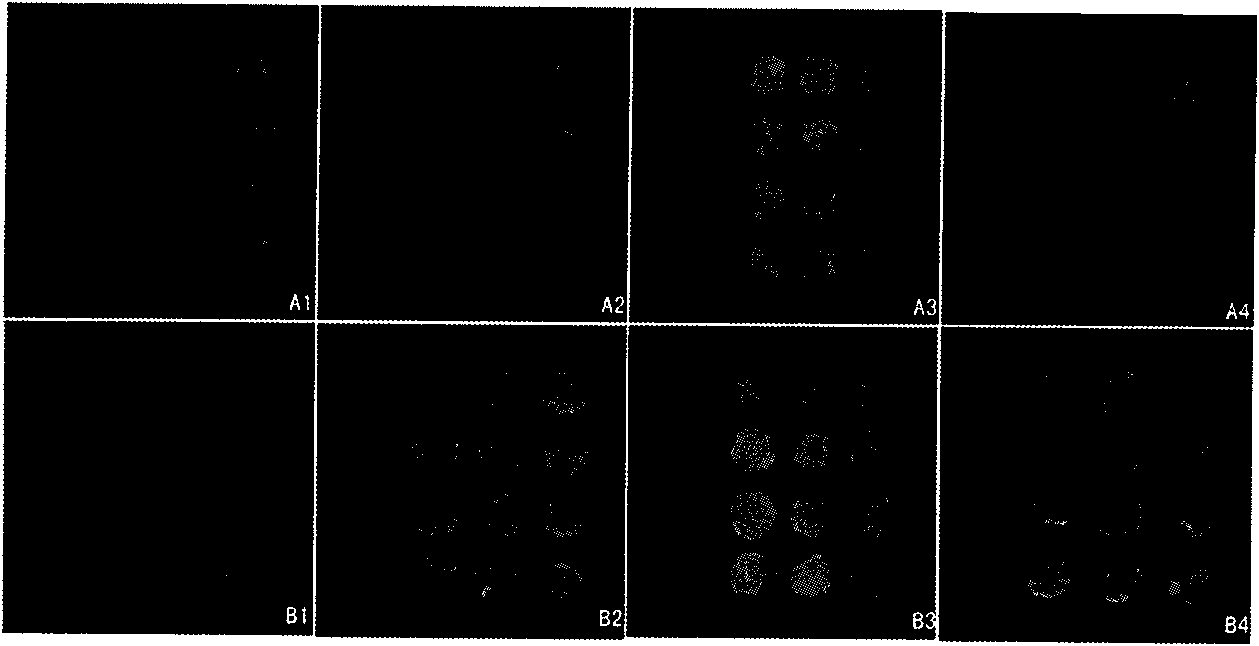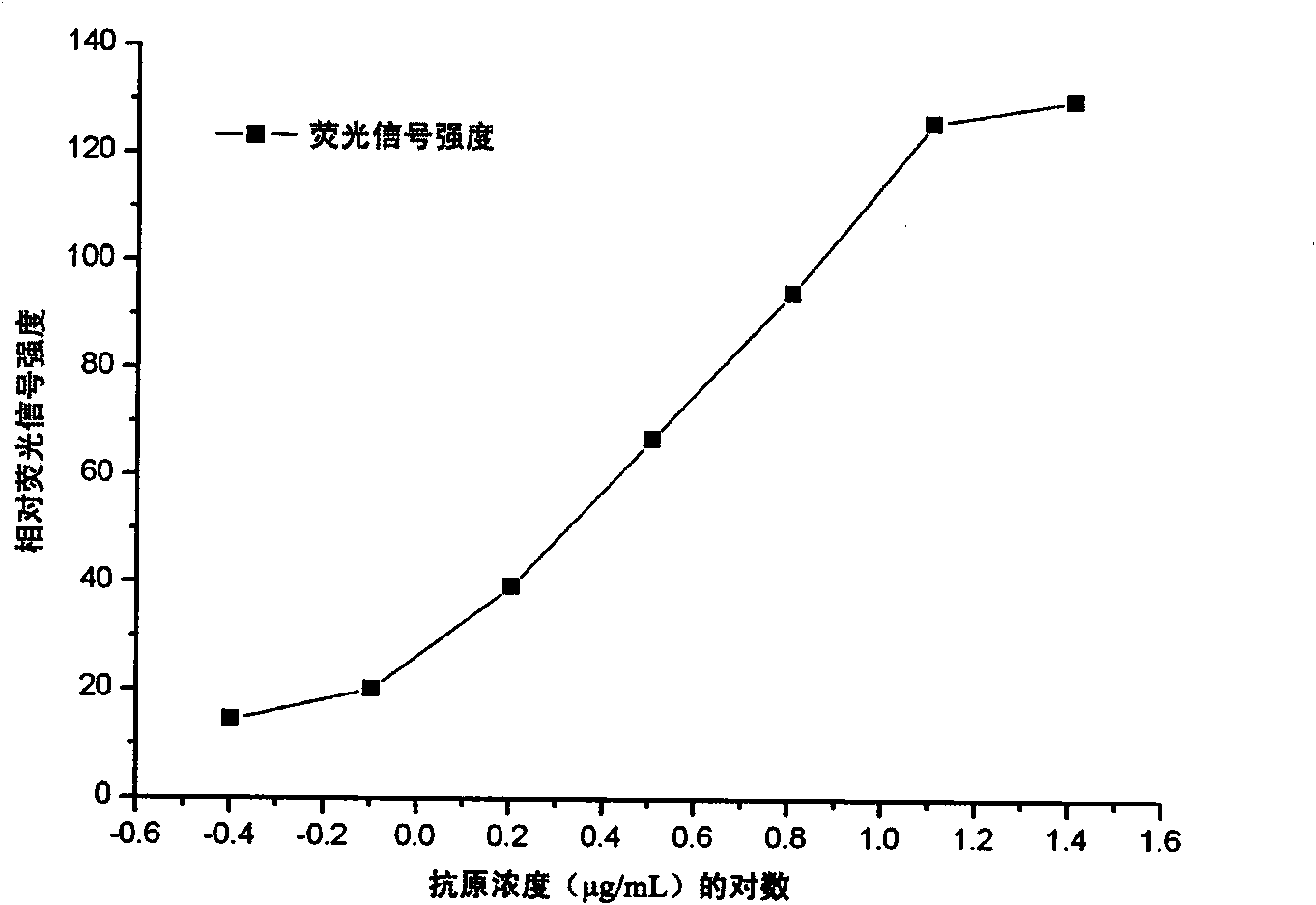Fish lymphocystis disease virus (LCDV) immunity detection chip and preparation method and application thereof
A lymphocyst virus, immunological detection technology, applied in the field of virology and biochip crossover, immunology, can solve the problems of sensitivity, specificity, accuracy can not be balanced, large limitations, etc., achieve low cost, increase reliability, The effect of increasing comparability
- Summary
- Abstract
- Description
- Claims
- Application Information
AI Technical Summary
Problems solved by technology
Method used
Image
Examples
Embodiment 1
[0047] 1. Antibody preparation and purification
[0048] LCDV was extracted from surface tumors of flounder suffering from lymphocyst virus disease, purebred New Zealand white rabbits were immunized by conventional methods, blood was collected to prepare serum, and rabbit anti-LCDV antibodies were obtained.
[0049] Resuscitate and culture mouse hybridoma cell lines monoclonal antibody B and monoclonal antibody C, inject a certain number of hybridoma cells into the peritoneal cavity of mice to produce ascites, and obtain a large amount of high-concentration, high-specificity, high-titer mouse anti-LCDV monoclonal antibody.
[0050] Monoclonal antibody B and monoclonal antibody C purified by affinity chromatography were mixed, and purebred New Zealand white rabbits were immunized by conventional methods, blood was collected to prepare serum, and rabbit anti-mouse Ig antibodies were obtained.
[0051] The resulting antibody was purified using an affinity chromatography column (H...
Embodiment 2
[0065] Steps 1, 2, 3, 4, 5 are the same as in Example 1.
[0066] 6. Antibody Immobilization
[0067] ① Dilute the rabbit anti-LCDV antibody with pH 7.4 PBS buffer containing 50% glycerol to a concentration of 0.5 mg / mL; dilute the rabbit anti-mouse Ig antibody to a concentration of 0.1 mg / mL.
[0068] ②Use a spotting instrument to spot the diluted antibody solution on different areas of the surface of the modified glass slide, and the dot matrix distribution is as follows: figure 1 As shown, there are eight 4×4 subarrays in two rows and four columns per chip, and the samples in each subarray are the same. Among them, the samples in the first column are phosphate glycerol buffer as a negative control; the second, The samples in the third column are rabbit anti-LCDV antibodies; the samples in the fourth column are rabbit anti-mouse Ig antibodies as positive control and fixed control and other quality control points. Each subarray is separated by a chip-specific fence Super P...
Embodiment 3
[0071] The sandwich method was used to detect fish lymphocyst virus.
[0072] Steps 1, 2, 3, 4, 5, 6 are the same as in Example 2.
[0073] 7. Pathogen detection
[0074] ①Take the fish tissues to be tested (epidermal, gills, stomach or intestines, etc.), mix them with liquid A at a ratio of 1:10 (W / V), homogenate, freeze and thaw repeatedly for 3 to 4 times, and after ultrasonic crushing, Centrifuge at low temperature, 5000rpm×15min, take the supernatant as a test sample, to be tested;
[0075] ② Add the samples to be tested to different subarrays of the same carrier of the above-mentioned chip. The sample loading volume is 10 μL / array. One chip can detect eight samples at the same time. Pay attention to avoid liquid mixing between different subarrays. Incubate at 37°C with saturated humidity for 15min, 30min, 45min, 60min, 90min, and 120min, wash, add diluted C solution on the chip, 10μL / array, place at 37°C with saturated humidity for 15min, 30min, 45min, 60min, 90min, an...
PUM
 Login to View More
Login to View More Abstract
Description
Claims
Application Information
 Login to View More
Login to View More - R&D
- Intellectual Property
- Life Sciences
- Materials
- Tech Scout
- Unparalleled Data Quality
- Higher Quality Content
- 60% Fewer Hallucinations
Browse by: Latest US Patents, China's latest patents, Technical Efficacy Thesaurus, Application Domain, Technology Topic, Popular Technical Reports.
© 2025 PatSnap. All rights reserved.Legal|Privacy policy|Modern Slavery Act Transparency Statement|Sitemap|About US| Contact US: help@patsnap.com



